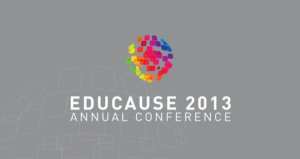For this weeks blog post, I’d like to reflect on my experiences in contacting several professionals and presenters from the Association for Educational Communications and Technology (AECT) 2013 International Conference. The assignment asked us to contact two individuals that presented at the conference and request their presentation proceedings. I contacted Prof. Brad Hokanson, from the University of Minnesota, and Jenny Wakefield and Scott Warren from the University of North Texas. Brad was very responsive to my original request. It took a few days to receive a response from Jenny. She was a great source of information, though, and was receptive to me after I told her I was pursuing my M.Ed. degree at the University of Minnesota. I also think Brad was more receptive to me after he learned about my educational goals. I plan to meet with Brad in a few weeks to further discuss his work (I’ll discuss more below).
With my interest in massive open online courses (MOOCs), I went ahead and contacted Prof. Brad Hokanson, PhD, University of Minnesota, on his presentation, “SMOOCH: The development of an internally targeted massive online course in creativity.” The project concept includes developing an online MOOC-like course (Semi-MOOC, hence the “S”) for incoming freshman to learn about creativity and problem-solving. Prof. Hokanson proposes about 1000 incoming freshman will enroll in the course, with the first cohort moving through next summer, 2014. If the course proves to be successful, the number of incoming freshman that enroll, could potentially increase significantly. The course will also not be a “traditional” lecture style course; it will be an active learning environment with a focus on problem-solving that requires students to be engaged actively online. Creativity seems like a difficult concept to teach online; but Hokanson notes the course will be structured with a series of challenges and problems to be solved, allowing creativity to be developed through the online interactions and collaborations. Students will also be peer reviewed and asked to participate in online discussions with other learners.
In my review of the proceedings, this course seems to align well with the online learning strategies and goals we’ve learned in CI5325. It will be interesting to see the design of the course online and how well it meets the needs of the learners. I plan to meet with Prof. Hokanson in the near future to discuss this course and his ideas to build a stronger undergraduate student experience and “teach” them to become more creative.
I also received a proceedings paper from Jenny Wakefield and Scott Warren from the University of North Texas on their work, “Learning and Teaching as Communicative Actions: Applications of the Theory to Mobile Learning.” The goal of their paper was to introduce learning and teaching as communicative actions theory as one theoretical support for using mobile devices and applications to support learning. Their theory of learning focuses on the communication affordances of mobile learning, and provides learners with meaningful, real world contexts. Learning and teaching as communicative actions theory (LTCA) is one such avenue that can be used to support the notion that mobile learning is a communication affordance to us. LTCA can be used as a model to see how we learn from mobile devices and may be the future “go to” theory in mobile learning. The paper was very interesting to read especially with my personal interest in mobile learning. Jenny also recommended a book for me, Handbook of Mobile Education, 2013. The book includes their paper, which I discussed above. This book provides a huge source of research and information related to the future of mobile technologies.
Overall, my communications with the presenters from AECT was very comfortable and well worth the couple of minutes I spent writing my emails. I plan to reach out to additional presenters from the conference in the future to learn more about some specific topics of interest to me.
![MP900444382[1]](http://onlinelearninginsights.files.wordpress.com/2012/03/mp9004443821.jpg?w=296&h=201) A paper published recently in the Journal of Online Teaching and Learning (JOLT) highlights (perhaps unknowingly) one of the most effective methods for teaching faculty and instructors how to become skilled in online pedagogy and instruction—walking-the-talk. In the paper instructors did exactly what the students need to do to learn effectively and deeply online, by collaborating, contributing knowledge, sharing and creating an artifact [in this case two online courses] virtually. What’s significant is that collaboration and learning occurred via technological applications, i.e. Skype, Google Docs, Dropbox, discussion forums, and Voicethread. The point is that the technology wasn’t the focus, but that robust, meaningful and productive learning occurred despite the technology. When used effectively technology, as apparent in this study, becomes invisible—transparent. Communicating…
A paper published recently in the Journal of Online Teaching and Learning (JOLT) highlights (perhaps unknowingly) one of the most effective methods for teaching faculty and instructors how to become skilled in online pedagogy and instruction—walking-the-talk. In the paper instructors did exactly what the students need to do to learn effectively and deeply online, by collaborating, contributing knowledge, sharing and creating an artifact [in this case two online courses] virtually. What’s significant is that collaboration and learning occurred via technological applications, i.e. Skype, Google Docs, Dropbox, discussion forums, and Voicethread. The point is that the technology wasn’t the focus, but that robust, meaningful and productive learning occurred despite the technology. When used effectively technology, as apparent in this study, becomes invisible—transparent. Communicating…
